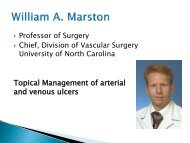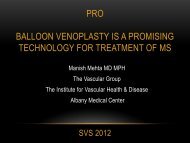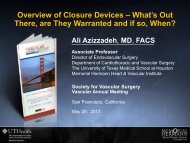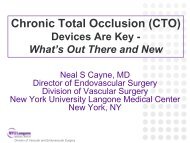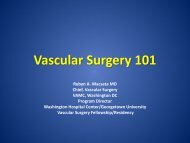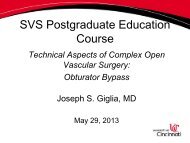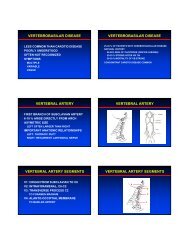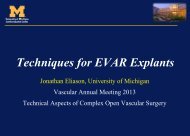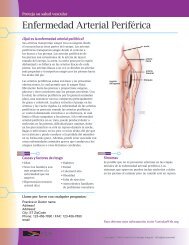Arch Debranching/Extraanatomic Bypass - VascularWeb
Arch Debranching/Extraanatomic Bypass - VascularWeb
Arch Debranching/Extraanatomic Bypass - VascularWeb
You also want an ePaper? Increase the reach of your titles
YUMPU automatically turns print PDFs into web optimized ePapers that Google loves.
Thoracic Aneurysms Extending<br />
Proximal to the Left Subclavian<br />
<strong>Arch</strong> <strong>Debranching</strong>/<strong>Extraanatomic</strong><br />
<strong>Bypass</strong><br />
Mark A. Farber, MD FACS<br />
Associate Professor of Surgery and Radiology<br />
Director Aortic Center<br />
University of North Carolina<br />
Chapel Hill, NC
Disclosures<br />
• Consultant for:<br />
– WL Gore<br />
– Cook Inc.<br />
– Bolton Medical
Device Implant Location<br />
• Proximal Sealing Region<br />
• Zone 0-1: 10-15%<br />
• Zone 2: 25%<br />
• Zone 3: 25%<br />
• Zone 4: 30%<br />
• Distal Sealing Region<br />
• Visceral: 10%
Great Vessel Reconstructions
<strong>Arch</strong> Aneurysms<br />
• Traditionally open repair has been the<br />
mainstay of therapy<br />
– Associated with a significant morbidity and<br />
mortality<br />
• Stroke<br />
• Endovascular therapy limited by presence of<br />
“healthy aorta” proximally<br />
• Hybrid approach overcomes these proximal<br />
issues and allows for endovascular repair<br />
5
Approaches to Minimize Stroke<br />
• Hypothermic circulatory arrest<br />
• Selective antegrade or retrograde<br />
cerebral perfusion<br />
• Mortality Rate: 0-19%<br />
• Neurologic Injury: 3-18%<br />
• Circulatory arrest > 30-40 min<br />
associated with worse outcomes<br />
6
• Trans-mediastinal<br />
Possible Solutions<br />
– Complete Reconstruction via sternotomy<br />
• Ascending/<strong>Arch</strong> reconstruction<br />
• Complete arch de-branching<br />
• Extra-thoracic<br />
– Partial Reconstruction<br />
• Extra-anatomic cervical bypasses<br />
• Concomitant or subsequent TEVAR for complete<br />
exclusion<br />
• Goal of therapy is to maintain flow to critical aortic<br />
branches<br />
7
Types of Repairs<br />
Trans-mediastinal<br />
Type I Type II Type III<br />
8
Types of Repairs<br />
<strong>Arch</strong> De-branching<br />
Zone 0 Zone 1 Zone 2<br />
9
Extensive Hybrid Repairs<br />
Type II<br />
• Type II arch repairs generally<br />
require frozen elephant trunk<br />
repair<br />
– Ascending aortic aneurysms<br />
• Limited extension into distal arch<br />
– Best used for ascending aortic<br />
aneurysms with minimal extension<br />
into distal arch<br />
– Endograft deployed during<br />
hypothermic arrest - “frozen”<br />
elephant trunk<br />
10
Published Results<br />
Type II Repairs<br />
Author Year No.<br />
Concomm.<br />
Proc<br />
30d<br />
Mortality<br />
Stroke<br />
SCI<br />
Survival<br />
(Yr)<br />
Mean F/U<br />
Uchida 2010 58 36% 0% 3.4% 3.4% 66% (8) 54+37<br />
Shimamura 2008 126 NR 3.2% 5.6% 6.3% 54% (8) 60+37<br />
Baraki 2007 39 59% 12.8% 12.8% 0% 87% (4) 22+7<br />
Flores 2006 25 20% 12% 16% 24% 60% (4) 35+13<br />
Sakurai 2006 23 17% 0% 4.3% 13% 73% (5) NR<br />
11
Extensive Hybrid Repair<br />
Type III<br />
• Stented Elephant trunk<br />
repair<br />
– Aneurysms involving the<br />
ascending aorta with arch<br />
and extensive distal<br />
descending thoracic<br />
aortic involvement<br />
– Typically a two-staged<br />
repair<br />
12
Trans-mediastinal <strong>Arch</strong> <strong>Debranching</strong><br />
Type I Repairs<br />
• Ascending landing zone<br />
• <strong>Arch</strong> de-branching repair<br />
Author Year N Mortality<br />
Central Neuro Event<br />
Transient<br />
Permanent<br />
SCI<br />
Morbidity<br />
Gottardi 2008 13 23% 7.7% 0% 0% NR<br />
Saleh 2007 16 7% 0% 0% 0% 25%<br />
Szeto 2007 8 12.5% 25% 0% 0% 50%<br />
Bergeron 2006 15 6.7% 0% 0% NR NR<br />
13
Extra-antomic <strong>Bypass</strong>es<br />
Extra-thoracic<br />
14
Aortic <strong>Arch</strong> De-branching Results<br />
Aurthor Year No.<br />
Trans-<br />
CVA SCI<br />
mediast. anatomic<br />
• Extrathoracic procedures 0 1 2 Mortality<br />
k<br />
are less invasive than<br />
those via stenotomy<br />
Extra-<br />
– Carotid-Carotid BPG<br />
– Carotid-SCA BPG<br />
Zone<br />
30 day<br />
• Limited in the extension of the proximal<br />
landing zone<br />
Endolea<br />
Mean F/U<br />
Lotfi 2012 51 8% 92% 8% 61% 31% 10% 12% 6% 15.7% 15<br />
Chiesa 2010 116 21% 54% 21% 23% 56% 3.5% 3.5% 1.7% 3.4% 27+15.7<br />
Holt 2010 78 12% 38% 12% 22% 66% 4% 11.6% 4% 2.5% NR<br />
Chan 2008 16 31% 69% 31% 50% 19% 0% 31% 0% 12.5% 14<br />
Gottardi 2008 73 67% 24% NR NR NR 6.8% 1.4% 0% 9.6% 37<br />
Totals 283 27% 50% 16% 32% 52% 5.2% 7.5% 2.4% 6.9% 27<br />
15
Carotid-SCA Revascularization<br />
Zone 2<br />
• Absolute Indications (pre-operative)<br />
- Dominant left vertebral artery w/<br />
Zone 2 coverage<br />
๏<br />
๏<br />
60% left vertebral artery dominant<br />
2% “PICA” syndrome<br />
- LIMA LAD CABG<br />
- Left handed patient<br />
- Left arm AV Fistula<br />
- Aberrant arch origin of left<br />
vertebral<br />
• Relative Indications<br />
- Coverage length > 20 cm<br />
- Prior AAA repair<br />
- Occlusive dz<br />
16
Reported Complications with<br />
Overstenting<br />
• Arm Ischemia: 6%<br />
• SCI: 4%<br />
• VBI: 2%<br />
• Stroke(ant): 5%<br />
• Death: 6%<br />
A<br />
B<br />
C<br />
17
(<strong>Arch</strong>) Conformation<br />
Achilles Heel<br />
18
Original TAG<br />
CTAG<br />
19
Conclusions<br />
Great Vessel Reconstructions<br />
• Provide an alternative option for these high risk<br />
patients<br />
• May reduce stroke and mortality however larger series<br />
are required<br />
• <strong>Arch</strong> de-branching reconstructions compared to other<br />
currently available techniques in the US have the most<br />
robust dataset wrt durability and outcomes to support<br />
its use over other techniques and open repair.



